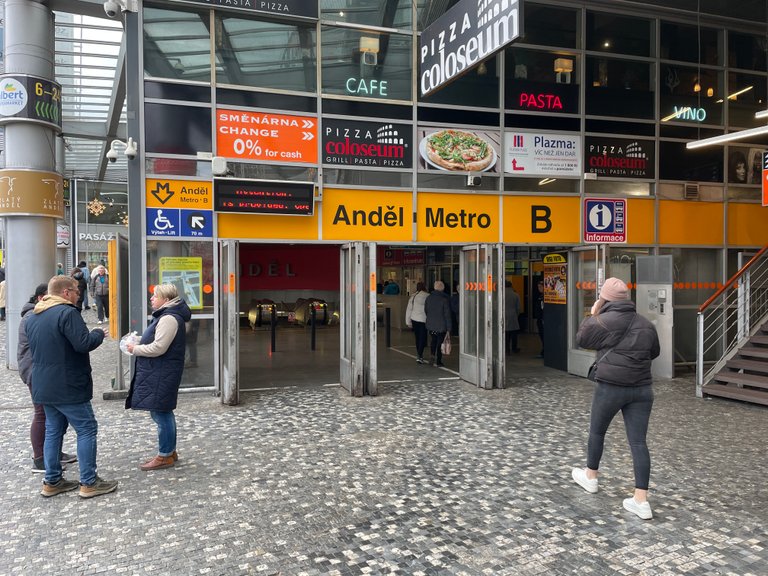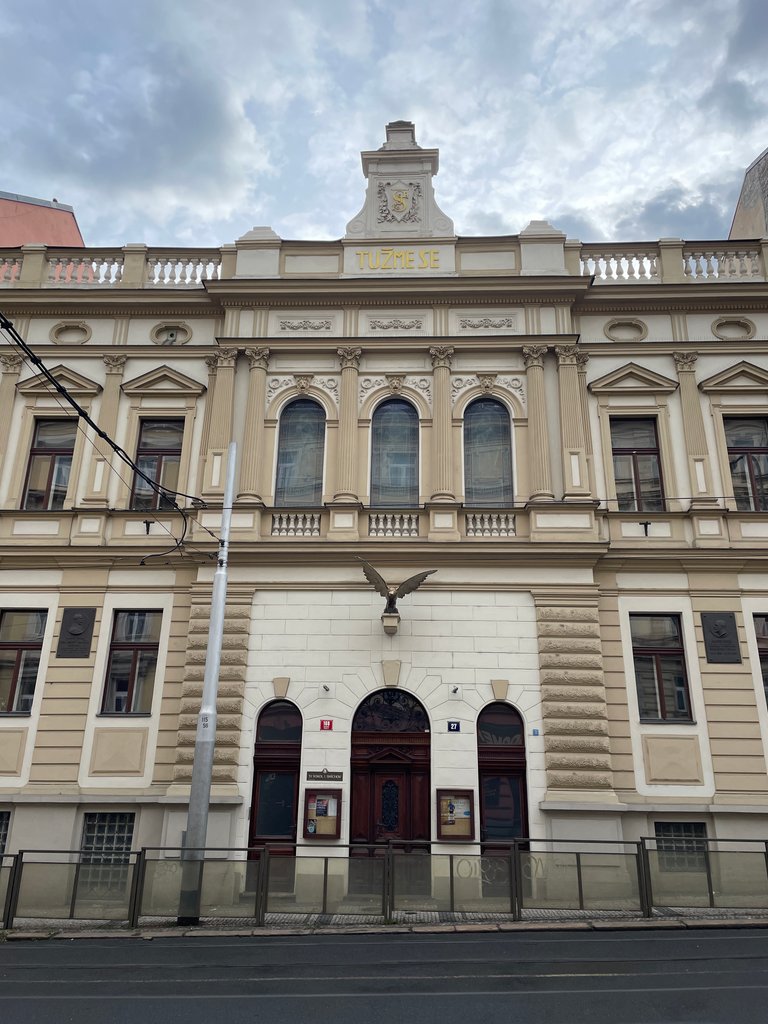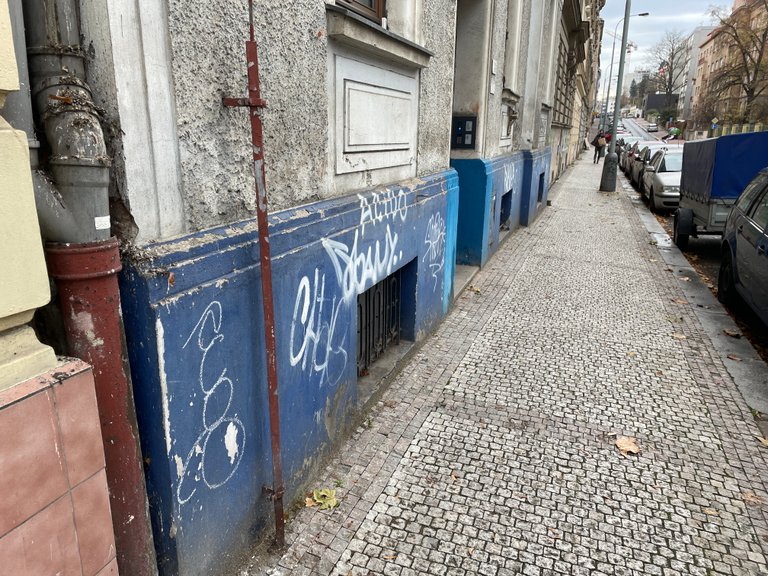Angel Station: A Smíchov WednesdayWalk, Prague
He’d been standing at the intersection, waiting for a tram when the sky coagulated. He sidestepped the people crowding onto the tram and looked. Watched the low cumuli in the slow-moving sky above Angel Station, saw them run through with a crimson vein, outlined in silver. Then the fleecy clouds let loose the red, caught him in the eyes, he’d had to lean against a lamppost.
The sky was red, It was dazzling, he tried to move, felt a drip, drop, drip on his shoulders, neck, scalp, knew it was blood.
Angel Station, a novel by Jáchym Topol, one of the the most-translated Czech authors
In Berlin, one could experience the Wings of Desire breeze when the city was torn in two, one half offering precarious shelter to Nick Cave - whose songs guide you through the black-and-white movie - David Bowie, or Iggy Pop, only to end up among the Children from Zoo Station. I imagine avoiding the pull of that infamous spot was impossible. Prague trailed behind for decades, its fate intertwined with Eastern Berlin's, as though they were soulmates under the same red star.
Eventually, the chains were shattered in Czechoslovakia, albeit a little behind schedule, if I may say so. The seventies, eighties, and nineties burst in all at once, like a beaver dam collapsing after heavy rains, releasing the pent-up waters to flood the land. That's what Topol brilliantly captures in the novel. That is what the area around Anděl in Prague was like back then – a place flooded with the retained decades, transforming everything and everyone.
Anděl (Czech for angel) has changed significantly over the past thirty years. It has become a thriving business district. Although most office buildings are disguised as ordinary residential blocks. Though off the beaten tourist paths, it still hums with a mix of languages, thanks to expats who work there. Modern Anděl boasts a large mall, two multiplex cinemas, a handful of good restaurants, a craft microbrewery, and more. Gone are the bleeding skies, the haunting voids where people seemed to vanish, the psychedelia, and the drug-fueled sects that blurred the lines between religion and addiction. Or are they?
Setting aside the present sparkle, let me show you the other side of Anděl – the side that still echoes the one portrayed in the novel, which is, without a doubt, worth reading.

That’s Anděl – one of the busiest public transport hubs in Prague, where crowds from the metro merge with streams of people flowing from trams and buses, as well as the nearby train station. The dominant building here, constructed in 2000, replaced an old corner house adorned with an angel fresco, which gave the crossing its name.

The rear view feels more Prague-like – cobbled, narrow streets that make the city center rather car unfriendly, and late 19th-century townhouses, many with additional stories added later. This neighborhood - Smíchov - was once a town outside the old Prague borders, a relatively rich one, as the architecture demonstrates.

The metro exit has been integrated into the newer building and recently gained crimson paint above the escalators. A reference to the novel, perhaps?

Before we move on, here is one final touch of modernity: the mall entrance, already with a decorated Christmas tree.

Prosperous Bohemian towns often hosted Jewish minorities, and Smíchov was no exception. The Smíchov Synagogue now stands amidst modern buildings, looking rather austere since a Functionalist reconstruction in the 1930s. It does not serve religious purposes since 1941 when it was seized by the Nazis and repurposed as a warehouse—a function later maintained by the communists. After the Velvet Revolution of 1989, the building was returned to the Prague Jewish Community and is now managed by the Jewish Museum in Prague.

I had thought the inscriptions were identical, but they actually cite two distinct verses from the Old Testament:
- "Peace, peace to him that is far off, and to him that is near" in Czech
- "Not by might, nor by power, but by my spirit, saith the Lord of hosts" in Hebrew

Leaving the Anděl crossing and heading west, I cannot miss these office houses. They house Seznam.cz, one of the rare companies in the world capable of beating Google in a local market.

Passing by the Smíchov Sokol movement gym, you might wonder how such a wealthy town, later a district of Prague, became so run-down. Well, being rich perfectly qualified you to become an enemy of the people under the communist regime. Residents were relocated, private shops were shuttered, large apartments were divided into smaller units, and workers for nearby factories moved in—including Roma families who were forcibly settled here. With no emotional ties to the area and insufficient funds to maintain the townhouses, the newcomers neglected them. You'll see it in a while.

But first, we will pause at the Lesser Town Cemetery, about three kilometers from Lesser Town. It was founded in 1680, yet most graves are from the second half of the 19th century. Most tombstone inscriptions are illegible, wiped by time. The sandstone statues are often decapitated, and some have lost their limbs.







Here's a rare, legible tombstone. Arguably one of the youngest around, from 1866.

Still, there is a grave that draws visitors. Anna Degenová, who died at just three years old in 1851. Legend says that she was an angel accidentally incarnated as a human child. When Anna tragically fell from a window and passed away, the angel is believed to have returned to heaven. It's been almost two centuries, and people keep bringing toys and flowers.

And now, finally, to the parts of Smíchov that still retain the Angel Station vibe—you will find them around this cemetery as unintended memorials. Year by year, they disappear as prosperity spreads through the district. If you ever read the book (which I genuinely recommend), this is the atmosphere you should picture.









It might be a tad early, but still: This is my #wednesdaywalk entry for the @tattoodjay’s initiative.
Česky
Jsem líný překládat text do češtiny, tak snad jen uvedu originál z knihy Anděl (protože strojový překlad tady teda opravdu nefunguje), a dodám pár maličkostí pro české čtenáře. Věřím, že zbytek bude pro zájemce srozumitelný i pro projetí překladačem. Pokud vím, stejně jsou tu hlavně proponenti strojových překladů:
Stál na křižovatce, snad čekal na tramvaj, a nebe si sedlo. Vyhnul se lidem deroucím se do tramvaje a díval se. Sledoval nízké mraky pomalého nebe nad křižovatkou u výstupu Anděl Exit, viděl mraky proťaté rudou žilkou, na krajích se stříbrným lemováním. Pak mu beránci začali spouštět červenou, chytal ji do očí, opřel se o kandelábr.
Nebe bylo rudý. Oslňovalo ho. Chtěl se pohnout, na ramenou, na krku, na temeni ucítil káp, kap, kráp, věděl, že je to krev.
Celá kniha je k přečtení třeba tady.
Jáchyma Topola asi nemá cenu představovat. Je to jeden z těch odvážnějších, kteří se do křížku s režimem dostali už jako puberťáci. Později se stal jedním z kritiky nejlépe hodnocených současných spisovatelů. Často se o něm píše i jako o nejpřekládanějším českém spisovateli své generace. Novelu Anděl asi také četl kdekdo, dostala se i do povinné četby. Nebo jste možná viděli film, který se ale podle mého moc nepovedl.
I když už jsou dneska znovu různé normalizační hvězdičky uznávanější než excentrici v přízemí, k tomuhle článku se jako doprovod skvěle hodí třeba album Nebe je rudý Moniky Načevy. Trocha trip hopu a trocha Topola. Snad neurazí.
Dnešní Anděl je každopádně místo, kde u poledního menu zaslechnete tak deset dvanáct jazyků. Jsou to vesměs Pražáci, nemám pocit, že by sem běžně zabloudily davy turistů. A tak se postupně mění i podniky v okolí. Vesměs se tu opravdu dobře najíte a napijete. Albert hned vedle metra má trochu jiný sortiment než prodejny stejného řetězce na periferii – ne že bych na tohle byl expert, ale vždycky koukám na nabídku řemeslných piv, a tady je více než slušná. Jsou tu řemeslné pekárny, řeznictví, obchod s čajem, minipivovar...
Jen o kus dál, okolo Malostranského hřbitova, přitom najdete dozvuky starého Anděla z doby nedlouho po revoluci. A o tom byl (krom doporučení současné české prózy zahraničním čtenářům) mimo jiné tenhle článek.
Posted Using InLeo Alpha
You can check out this post and your own profile on the map. Be part of the Worldmappin Community and join our Discord Channel to get in touch with other travelers, ask questions or just be updated on our latest features.
"Food Avenue" sounds like it would be my kind of place! :)
Well, this neighborhood is among the best ones in Prague when it comes to fine dining ;)
Oh, I don't do much fine dining, but I do enjoy eating! :)
Hehe :)
Really nice street shots, but this is so sad
I find it rather peculiar - people just picked a random grave and keep visiting it :)
Great visual tour and historical perspective! Thanks for the "dare". ;)
Thanks, I am glad you enjoyed this bit of the Old World :))
Nice walkies. Have you been in the metro station? Very curious how the look inside. I asumr it has got an 80s vibe
Yep, I've been there many times, but I've never captured it. It does have a 80's vibe, though - see the shots on Wikipedia: https://en.wikipedia.org/wiki/And%C4%9Bl_(Prague_Metro)
Yeah, indeed, that looks so awesome. I really want to take pictures there someday.
@softa published several posts mapping Prague metro, browse few months back on his wall.
I made photographs of Anděl station, but i didn't present it. Anděl is build in same style as Moscow or Kiev metro stations.
This is simply amazing. Thanks for the tour and for sharing the history of this place. The graveyard is very interesting.
I guess you'd be impressed by Prague then, this is just fragment of it ;)
Well, one of my biggest wishes is to travel around Europe and know its history. I hope I can do it soon.
Travelling across Europe is extremely affordable off-season, the flight tickets can drop to like $10-20 one way. And if you're not picky when it comes to accomodation, there's plenty of all right hostels available everywhere.
Well, I'm planning to move in somewhere in Europe first and then start my journey, but I don't know where to move in yet.
Oh, than it depens on your profession and language skills I guess :)
Well, I work at marketing, although I'm not very experienced on it. I'm still learning. And I speak English and I'm learning Spanish. I would like to learn Portuguese and Italian too.
These will all come in handy ;)
Thank you very much. Where do you think I should move in to?
Prague is a great place to start your proffesional career, you can easily find an entry level job here. Large german cities are great when it comes to salary. Scandinavia is worth considering too. Mediterranean islands are quite all right for digital nomads. And so on ;)
Do your reserch and ask your fellow-countrymen who live in Europe. Also, check the working permit policies.
That's amazing information. Very useful. Thank you very much. I'm adding this comment to my bookmarks.
Hehe :) You're welcome.
Thanks :)
Anděl bejval hodně divokej v devadesátkách. Pamatuju si na jednu scénku od prodejny Sony co bývala naproti přes ulici než je vstup do metra. Stojí dvě cigošky před výlohou a koukají na kazetovýho walkmana. Jedna druhý povídá. "Já bych ho chtěla" a druhá odpovídá "tak si vem".
No, tohle já jsem nezažil, případně nemůžu pamatovat :))
I've not been there, but a lot of European cities have a certain look. The trams stand out as we don't have them in many places in the UK. Cemeteries can be fascinating as you ponder the stories behind the monuments.
Nice pics.
Well, trams are keen for Prague to me, even more than metro - they make the difference. As you can see at the first few shots, they have priority in the very city center, where cars are limited.
I'm glad you liked the post :)
I've been around a lot of Europe and ridden a few trams. Actually when I lived near Freiburg I never rode the trams there, but then I tended to just need to walk around the city centre.
I visaited Prague years well decades ago but did not get to see as much of it as I would have liked so found this post and tour so interesting
Thanks for joining the Wednesday walk
Have a great day
The post presented some less touristy spots ;) I am glad you liked it!
I think the less touristy spot tells visitors more about the real life in the city when I used to travel I couldnt wait to get away from the popular tourist spots
Thank you for your post. I feel like I traveled to Prague
Pěkný post!
Já už taky ledacos pamatuju a vždy žasnu, jak se některá místa ve městě mění a někde jako by se zastavil čas...
Přiznám, že Anděl Exit jsem viděl v prvních letech po vzniku, takže dnes už je tak nějak zapomněn, ale nějak odvázaný jsem z něj nebyl.
Zato Načeva mě neurazí v žádné tvorbě, byť já preferuji desku Možnosti tu jsou, což bylo první zhudebnení Topolových básní... A jelikož hudbu moc neškatulkuju, budu si muset doplnit vzdělání a podívat se, co vlastně znamená to trip hop 😉
Ten film je hrozný, ale kniha je super :)
Já si po dvaceti letech pamatuju, že se mi nelíbil... Znova se v tom utvrzovat nebudu...😉
:)